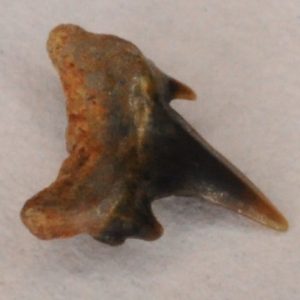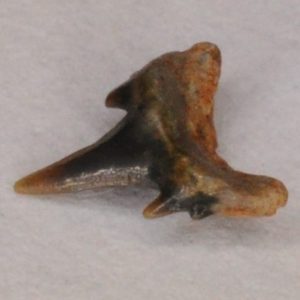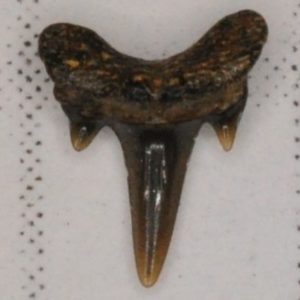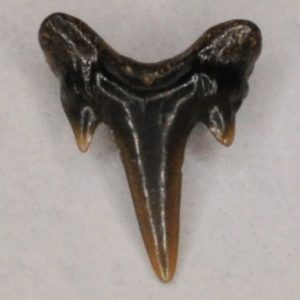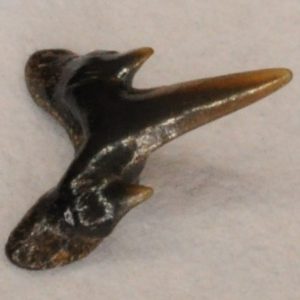NJfossils.com
"Fossils aren't a hobby, they're a lifestyle."Sand tiger (Eostriatolamia holmdelensis aka Carcharias holmdelensis)
Age – Late Cretaceous; Commonality – Less Common; Size – average: ½ inch, max: ¾ inch This shark is named after the town of Holmdel and is the second species of Carcharias present. This is the only sand tiger that has striations. The anterior teeth are slender and lateral teeth are curved slightly and can have secondary cusplets on them. They resemble Carcharias samhammeri teeth in other aspects.
First Lower Anterior (Parasymphyseal) Tooth
Parasymphyseal E. holmdelensis teeth are scarcer than the other tooth positions of the species. They are smaller and not as symmetrical as the other teeth. The largest root in a symphyseal tooth points away from the symphysis unlike the anterior teeth, which have their largest root pointing toward the symphysis.
Anterior Teeth
The anterior teeth are long and slender. They are relatively straight and have fairly strong striations. This adult tooth is a lower anterior (likely an a2).
This tooth is from an adult shark and is an upper anterior (likely an A1).
This tooth is probably from an adult shark and is a lower anterior (likely an a3).
This upper anterior tooth is either an A2 or an A3.
Intermediate Tooth
Intermediate teeth are scarcer than the other types of teeth; they are about as common as the parasymphyseals. A single file of intermediate teeth are positioned between the last anterior tooth and first lateral tooth in the upper jaw of some sharks. They are often (though not always) smaller than the neighboring teeth; it seems like they are smaller than the anterior teeth and approximately the same size as the lateral teeth in E. holmdelensis. They are angled distally when in the jaw in most species, including E. holmdelensis.
Lateral Teeth
This tooth is an upper lateral. Upper lateral teeth are smaller (shorter) than anterior teeth and are also much more slanted distally. Their width to length ratio is greater than in anteriors. Their striations are slightly weaker than on anteriors.
Lower laterals are more symmetrical than the anteriors in E. holmdelensis. They are erect and bear a resemblance to S. texanus lower laterals.
This tooth is another lower lateral. This one has a lower crown than the one above.
Posterior Teeth
This tooth is an upper posterior. Upper posteriors are even more curved distally than the upper laterals. It also seems like they have a larger lingual protuberance and nutrient groove.
This is a lower posterior tooth. Lower posterior teeth resemble lower lateral teeth, but are slightly more angled distally. The striations are also less prominent.
This tooth is another lower posterior. It is from further back in the mouth in comparison to the one shown above.
































